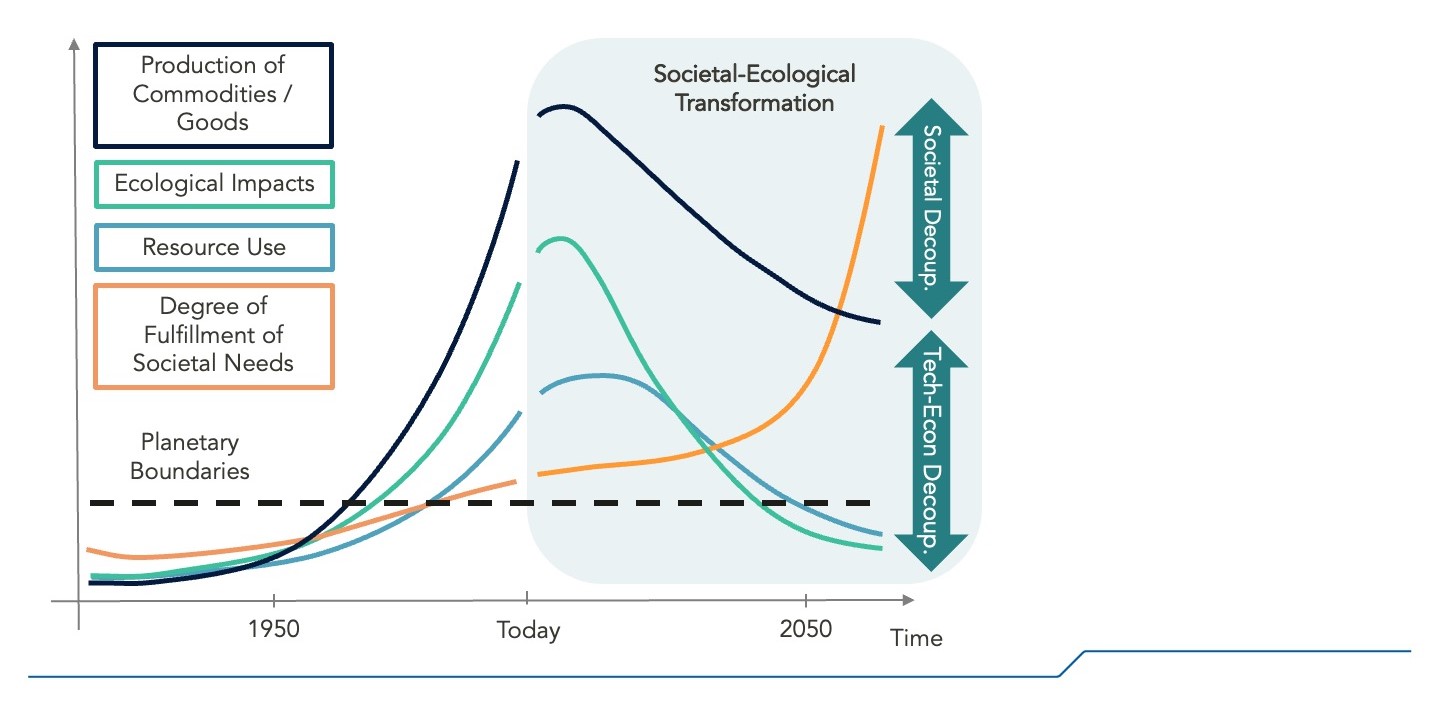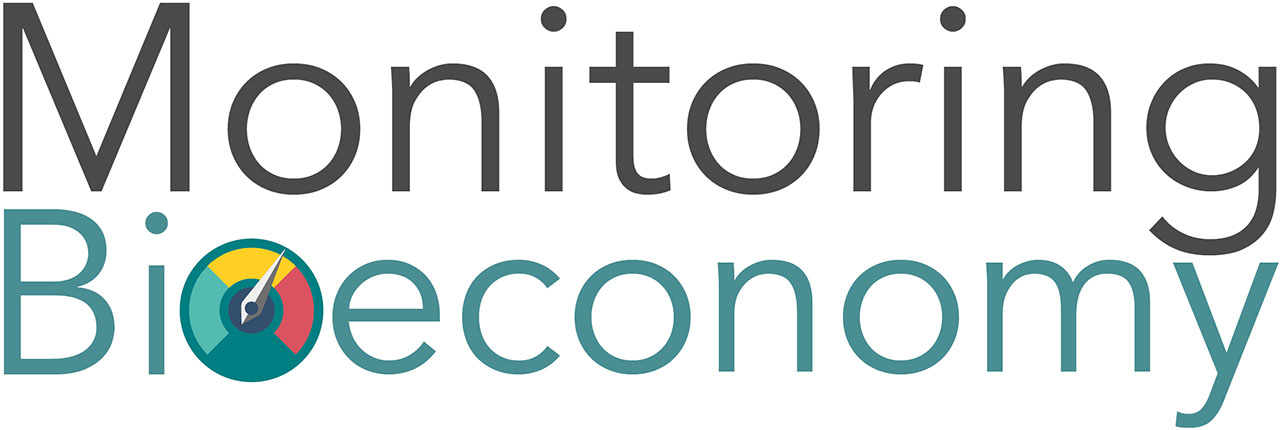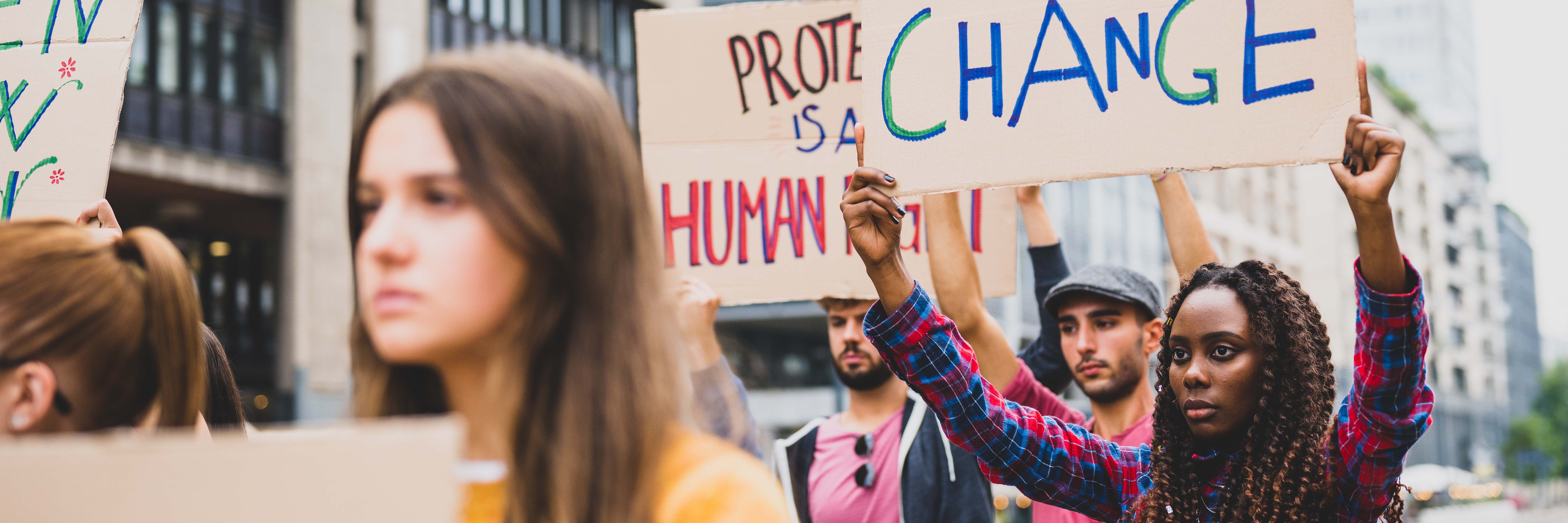Social impacts and relevance go beyond the indicators of e.g. jobs and revenues. A sustainable bioeconomy requires changed business practices and consumer behavior to enable circularity and consumption within planetary boundaries. More cutting-edge monitoring of social change requires linking to existing and developing further indicators on social innovation and a societal-ecological transformation.
What is a societal-ecological transformation?
A societal-ecological transformation describes the pathways and goals for a future in which (1) societal needs are fulfilled, (2) in a way that stays within the planetary boundaries [1]. A bioeconomy that is effective (fulfills societal needs), efficient (achieving most with less) and just (nobody falls behind) is part of this transformation. The figure below visualizes key criteria.

Societal-ecological transformation and double decoupling as qualitative trends (Source: Zeug et al. (2023) [8]).
The planetary boundaries describe the main ecological limits for both resource use (land, water, biodiversity) and ecological impacts (greenhouse gas emissions, pollution). These boundaries are not necessarily constant over time, and they are connected [2]. They also contain a normative element as regards risk acceptance, and have been characterized from a political ecology perspective as contested [3]. They are depicted as a constant boundary line in the above figure as a qualitative simplification.
Ecological impacts and resource use grew at significant rates, especially since the 1950s. Both trends are displayed as qualitative trends derived from quantitative data [4] in the figure above. These trends are driven (root causes) by the production of material and immaterial commodities (e.g. GDP), which has experienced even higher levels of exponential growth [4]. In contrast, the development of social indicators, like the human development index, has shown little growth (not even a linear trend). This illustrates how disproportionally [5] societal needs fulfillment is (currently) coupled to commodity production.
A double decoupling is needed. This means both a societal and techno-economic decoupling, which are mutually dependent processes of transformation. A societal decoupling means decoupling the degree of fulfillment of societal needs from an increasing production of material goods. It requires a reconsideration of the “ends” and “means” in current economic systems; i.e. economy as a satisfaction of societal needs (ends) through natural resource use, labor and technologies (means). Innovation and sustainable technologies alone will not solve this mainly political challenge [6]. Sufficiency also plays a major role. For example, diminishing marginal utilities have been identified for most of the biophysical–social indicator linkages. This means that from a certain degree of affluence and fulfillment of societal needs, every additional unit of resource use contributes less to social performance [7]. Without a societal decoupling, relative decoupling (less impacts per product, techno-economic decoupling) may be achieved, but absolute decoupling (less impacts in total) is not plausible in a fast-growing economy [8].
Hence, a societal-ecological transformation and sustainable bioeconomy may correspond to what has been described as the “Planned Transition“ techno-political vision of the bioeconomy [9]. This means that on the one hand advanced technologies on a large-scale industrial level (integrated biorefineries, cascading use, eco-functional intensification of certain agricultural sectors, global trade in certain biogenic commodities, use of high-tech biotechnologies) will be needed to achieve the very ambitious demands on resource efficiency [10]. On the other hand, further physical growth of mass flows, capital accumulation and an invisible hand are not a necessary part of the bioeconomy. Instead, the concepts of reduce, reuse and recycle must be put into practice — in that order — in a circular bioeconomy.
Such a transformation will have to innovatively address normative and socioeconomic barriers, like global political patterns of regulation and resulting production and consumption patterns, as well as the technological and ecological challenges. For example, technological inventions must go hand in hand with social, economic and organizational innovations, and questions of scale arise in the field of tensions between a global socio-ecological crisis and the responsibility and scope for action at local and regional levels [8].
For bioeconomy monitoring this implies the need for a monitoring toolbox that accounts for multi-scale, multi-dimensional challenges. It must include methods to account for the resource use of the bioeconomy (primary biomass flows from agriculture, forestry and fisheries , as well as progress toward the circular bioeconomy by monitoring secondary resource flows), the ecological impacts associated with the bioeconomy (water use, biodiversity loss, pollution, etc.), and its contribution to fulfilling societal needs (food and commodity consumption, including issues of distribution, innovation, sufficiency, and participation).
Notes and references
- That said, terms and concepts of transformations towards sustainability remain fuzzy and there is much ambiguity and disagreement about the meaning and function of these concepts. See also, Görg et al. (2017). Challenges for Social-Ecological Transformations: Contributions from Social and Political Ecology. Sustain. doi: 10.3390/su9071045
- For example, the transgression of one planetary boundary may lead to transgressions of others (e.g. climate change can induce water scarcity and land degradation). The concept of planetary boundaries was introduced and further developed by Rockström et al. (2009). A safe operating space for humanity. Nat. Available at: https://www.nature.com/articles/461472a and Steffen et al. (2018). Trajectories of the Earth System in the Anthropocene. doi: 10.1073/pnas.1810141115
- Görg (2015). Planetarische Grenzen. Wörterbuch Klimadebatte. doi: 10.1515/9783839432389-031 and Bauriedl (2016). Politische Ökologie: nicht-deterministische, globale und materielle Dimensionen von Natur/Gesellschaft-Verhältnissen. Geogr. Helv. doi: 10.5194/gh-71-341-2016.
- Roser (2022). Our World In Data. Available at: https://ourworldindata.org/.
- These qualitative trends correspond more to industrialized countries of the global North and negative impacts are shifted especially to the global South.
- This does not mean that there is a contradiction between substitution and innovation. On the contrary, innovation is one of the prerequisites for substitution.
- O'Neill et al. (2018). A good life for all within planetary boundaries. Nat. Sustain. doi: 10.1038/s41893-018-0021-4.
- Zeug et al. (2023). Life Cycle Sustainability Assessment for Sustainable Bioeconomy, Societal-Ecological Transformation and Beyond. Progress in Life Cycle Assessment. Sustainable Production, Life Cycle Engineering and Management. Springer.
- Hausknost et al. (2017). A Transition to Which Bioeconomy? An Exploration of Diverging Techno-Political Choices. Sustain. doi: 10.3390/su9040669
- See the following for sources:
- Olsson et al. (2016). Cascading of woody biomass: definitions, policies and effects on international trade. Available at: https://task40.ieabioenergy.com/wp-content/uploads/sites/6/2013/09/t40-cascading-2016.pdf
- Nitzsche et al. (2016). Techno-economic assessment of a wood-based biorefinery concept for the production of polymer-grade ethylene, organosolv lignin and fuel. Biores. Technol. doi: 10.1016/j.biortech.2015.11.008
- Aguilar et al. (2018). Preface to the special issue bioeconomy. New Biotechnol. doi: 10.1016/j.nbt.2017.06.008
- Panoutsou, et al. (2013). Biomass resource efficiency for the biobased industries. Joint Res. Cent.



